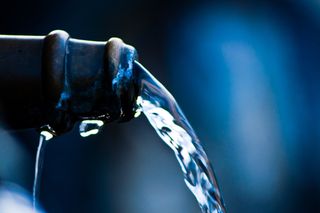
...................................................................................................................................................................
Drinking
'Raw Water'
Why People Are Drinking 'Raw Water' (But Probably Shouldn't)
By Brandon
Specktor, Senior Writer
Would you like your water sparkling, from the tap or
hauled out of an unsterilized river upstate?
For proponents of the expensive new drinking trend known
as "raw water," the choice is as clear as a Poland Spring.
According to a New York Times article published last week, a growing number of American
hydration connoisseurs are turning off their taps and switching to unfiltered,
untreated water from natural sources, shelling out up to $36.99 for a
2.5-gallon jug of the "raw" stuff.
While any individual with access to groundwater could
ostensibly obtain their own supply, specialty raw water companies are seeing
their products fly off store shelves (primarily in Silicon Valley, the Times
noted), while tens of millions of dollars in venture capital flows back in.
Why? Isn't raw water just water — only less regulated?
According to the Times, part of the movement's success may
come from that very "off the grid" appeal: Raw water passes through
no federal or municipal pipes, contains no additives (such as fluoride, a naturally occurring
mineral typically added to tap water to fight tooth decay), and generally receives no
filtration, ensuring every bottle remains as mineral-rich as Mother Nature
intended.
Unfortunately, Mother Nature sometimes intends to give you
an unpleasant case of diarrhea instead.
Even America's most pristine-looking springs can harbor
natural contaminants that make drinking their waters a sickly mistake, said
Vince Hill, chief of the Waterborne Disease Prevention Branch at the Centers
for Disease Control and Prevention (CDC) in Atlanta.
Without an intimate knowledge of where your water comes
from, it's hard to say what's in it and who handles it on its journey from
spring to bottle — this is why water gets filtered in the first place, Hill said,
and why the Environmental Protection Agency (EPA) enforces strict quality
guidelines on America's public water providers.
Something in the water
According to the World Health Organization (WHO),
contaminated drinking water is one of the most dangerous preventable health
risks the world faces.
"Contaminated water can transmit
diseases such diarrhea, cholera, dysentery, typhoid and polio," the WHO says, adding that contaminated drinking water is estimated to
cause 502,000 diarrheal deaths around the world each year.
The United States' public drinking water is among the
safest in the world, according to the CDC, thanks in part to a multistep purification process that
includes filtration, sedimentation (a process by which heavy particles of dirt
are separated out) and disinfection.
Cities and states have their own specific protocols for
cleaning public drinking water depending on the water source they draw from,
Hill said, but all of them follow one set of strict EPA guidelines aimed at
eradicating 90 well-known water contaminants.
"There are many sources of water
contamination, and some of those sources are naturally occurring," Hill told Live Science.
"Spring water and mountain
stream water may look pure, but it can be contaminated with things like
bacteria and viruses, parasites and other contaminants that you can't
see."
Chemicals like arsenic and radon, which occur naturally in soil and rocks but can be
poisonous in large enough doses, can easily seep into groundwater without much
indication, Hill said.
Animals, meanwhile, pose their own risks: Parasites like Giardia and Cryptosporidium, two of the most common causes of waterborne diseases in
the United States, easily spread from animal feces into natural water sources.
Once ingested by humans, these parasites lead to nasty
diarrheal diseases, the CDC says.
For this reason, the agency recommends that all backcountry water (sourced from a spring or
otherwise) be properly filtered, disinfected or boiled before consumption.
"We recommend filtering and
disinfecting [spring water] to make it safe," Hill said.
"Just because you're in a
natural area doesn't mean there aren't bacterial pathogens in the water that
you just can't see."
And while some raw-water purists "contend
that the wrong kind of filtration removes beneficial minerals … [and] kills
healthful bacteria," the Times reported, Hill does not think this
argument holds water.
"The basic benefit of drinking
water is hydration — that's how it benefits our bodies, improving our mental
process and bodily functions,"
Hill said.
"There's not much data on
whether water helps provide microbes for digestion and things like that. What
we do think about when we think about microbes in water [are] germs that could
cause diseases.
“That's why we talk about treating
water, filtering water, disinfecting water to make it safer — the data we do
have is more about the disease-causing effects of microbes in our
water."
Originally published on Live Science.
Brandon Specktor
Senior Writer
Brandon Specktor writes about the science of everyday life for
Live Science, and previously for Reader's Digest magazine, where he served as
an editor for five years. He grew up in the Sonoran Desert, but believes
Sonoran hot dogs are trying way too hard.


No comments:
Post a Comment